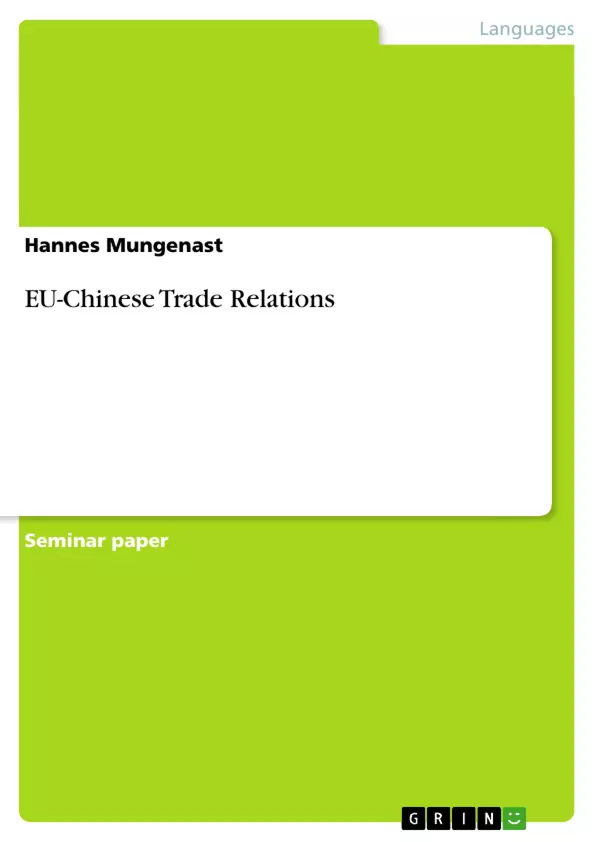The EU-Chinese trade relations are a very important aspect of today’s world economy and are expected to even increase in future. These trade relations are equally important for both sides and will have a strong impact on the future of both parts.
First of all, chapter 2 gives a summary of the most important aspects of trade-related statistics about China and the EU to give an overview of the two parties. In chapter 3, the history of the EU-Chinese relations and the most essential trade statistics will be presented. Before ending with an overall conclusion, chapter 4 will deal with some special trade issues of importance, like technological cooperation, the textile conflict and the everlasting issue of intellectual property rights.
Inhaltsverzeichnis (Table of Contents)
- 1. Introduction
- 2. EU and China
- 2.1. General Facts
- 2.2. Geography and History
- 2.3. Economy
- 3. EU-Chinese Trade
- 3.1. History
- 3.2. Trade Statistics
- 4. Special Trade Issues
- 4.1. Technological Cooperation
- 4.2. Textile Conflict
- 4.3. Intellectual Property Rights
- 5. Conclusion
Zielsetzung und Themenschwerpunkte (Objectives and Key Themes)
This paper aims to analyze the EU-Chinese trade relations, highlighting their significance in the global economy and their future prospects. The paper examines the historical development of these relations and explores key trade statistics. It also delves into specific trade issues, including technological cooperation, textile conflicts, and intellectual property rights.
- EU-Chinese trade relations and their importance in the global economy.
- Historical development of EU-Chinese trade.
- Key trade statistics between the EU and China.
- Special trade issues, including technological cooperation, textile conflicts, and intellectual property rights.
- Future prospects of EU-Chinese trade relations.
Zusammenfassung der Kapitel (Chapter Summaries)
Chapter 1 introduces the paper's topic and provides an overview of its scope and structure. It highlights the importance of EU-Chinese trade relations in the global economy and emphasizes the need for a comprehensive understanding of these relations.
Chapter 2 provides an overview of the EU and China, focusing on statistics relevant to trade. This chapter compares the two countries' size, population, age structure, population growth rates, and life expectancy. It also briefly touches upon their political leaders.
Chapter 3 delves into EU-Chinese trade, examining its historical development and providing key trade statistics. This chapter analyzes the trends and patterns in trade between the two regions.
Chapter 4 focuses on specific trade issues, including technological cooperation, textile conflicts, and intellectual property rights. It examines the challenges and opportunities associated with these issues.
Schlüsselwörter (Keywords)
EU-Chinese trade relations, global economy, trade statistics, historical development, technological cooperation, textile conflicts, intellectual property rights, trade issues, future prospects.
- Citation du texte
- Hannes Mungenast (Auteur), 2007, EU-Chinese Trade Relations, Munich, GRIN Verlag, https://www.grin.com/document/70140



